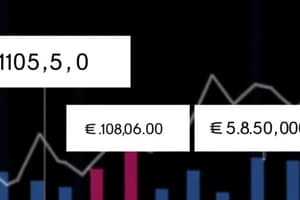Podcast
Questions and Answers
The Classical macroeconomic model proposes that______ and the Keynesian macroeconomic model proposes that________
The Classical macroeconomic model proposes that______ and the Keynesian macroeconomic model proposes that________
- Government intervention is required to help the economy reach its potential; markets work efficiently to produce the best macroeconomic outcomes.
- Government intervention is an appropriate tool to steady the economy; the economy is fairly stable.
- Changes in the quantity of money are critical in driving economic growth; real GDP equals potential GDP as long as inflation equals zero.
- Markets work efficiently to produce the best macroeconomic outcomes; the economy is inherently unstable and government intervention is required to maintain continued economic growth. (correct)
The idea that potential GDP is the sustainable upper limit of production means that
The idea that potential GDP is the sustainable upper limit of production means that
- Real GDP must always be the same as potential GDP in a growing economy.
- Real GDP may be temporarily larger than potential GDP, but not permanently. (correct)
- Unemployment can only temporarily be zero in a healthy economy.
- Nominal GDP may be temporarily less than potential GDP.
A country reports that its actual real GDP is greater than its potential GDP. It must be that
A country reports that its actual real GDP is greater than its potential GDP. It must be that
- More workers decided to quit work in order to enjoy leisure time.
- An error was made when calculating actual real GDP.
- The excess by which real GDP exceeds potential GDP is only temporary, and eventually, real GDP will decrease to be equal to potential GDP. (correct)
- The unemployment rate is temporarily zero.
The production function describes the relationship between____, along the production function the factor of production that is NOT fixed is , and as additional units of the factor of production (that is not fixed) are employed, holding all other factors constant,____
The production function describes the relationship between____, along the production function the factor of production that is NOT fixed is , and as additional units of the factor of production (that is not fixed) are employed, holding all other factors constant,____
Point A is____, and point B is_______ in relation to a nation's production function.
Point A is____, and point B is_______ in relation to a nation's production function.
An increase in the real wage rate ________ the quantity of labor demanded, ______ the quantity of labor supplied, and when the labor market is in equilibrium,_________
An increase in the real wage rate ________ the quantity of labor demanded, ______ the quantity of labor supplied, and when the labor market is in equilibrium,_________
Which of the following increases frictional and/or structural unemployment?
Which of the following increases frictional and/or structural unemployment?
The presence of efficiency, minimum and union wages
The presence of efficiency, minimum and union wages
The equilibrium real wage rate is ________ and the full employment Real GDP is ________ billions of dollars.
The equilibrium real wage rate is ________ and the full employment Real GDP is ________ billions of dollars.
If the government imposes ________ that firms must at least pay, the effect will be ________ because ________.
If the government imposes ________ that firms must at least pay, the effect will be ________ because ________.
Study Notes
Classical vs. Keynesian Models
- Classical macroeconomic model asserts that markets efficiently create optimal macroeconomic outcomes.
- Keynesian macroeconomic model contends that the economy is unstable, necessitating government intervention for sustained growth.
Potential GDP
- Potential GDP represents the sustainable maximum output achievable in an economy.
- Real GDP can temporarily exceed potential GDP but cannot do so permanently.
Real GDP vs. Potential GDP
- If actual real GDP exceeds potential GDP, the discrepancy is temporary, and real GDP will realign with potential GDP.
- Full employment is not sustainable if actual output surpasses potential output.
Production Function
- The production function illustrates the relationship between real GDP and labor employed.
- Labor is the variable factor of production that is not fixed; increases in labor lead to diminishing returns in GDP.
Points on the Production Function
- Point A is attainable if resources are used efficiently, while Point B is considered unattainable given the economic conditions.
Labor Market Dynamics
- An increase in real wage rate leads to decreased labor demand and increased labor supply.
- In equilibrium conditions, full employment and optimal potential GDP are achieved.
Unemployment Factors
- Frictional and structural unemployment can increase due to:
- A surge in young workers entering the job market.
- More generous unemployment benefits affecting job-seeking behavior.
- Structural slumps in certain industries leading to job losses.
Job Rationing
- Efficiency wages, minimum wages, and union wages can cause job rationing by raising real wages above equilibrium.
Labor Market Equilibrium
- Equilibrium real wage rate determined at $40 corresponds with full employment Real GDP of 4.2 billion dollars.
Government Interventions in Labor Market
- Imposing a minimum wage of $10 leads to increased unemployment because it creates a surplus of labor.
Studying That Suits You
Use AI to generate personalized quizzes and flashcards to suit your learning preferences.
Description
Test your knowledge of macroeconomic models with these flashcards from Chapter 8. Explore the differences between the Classical and Keynesian approaches to economic stability and government intervention. Perfect for students looking to reinforce their understanding of these critical concepts.




